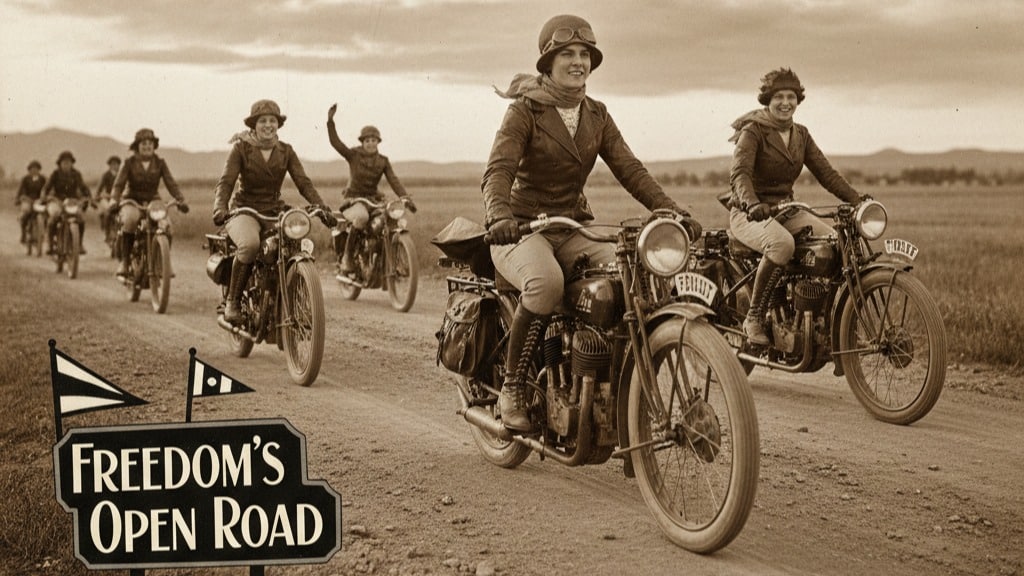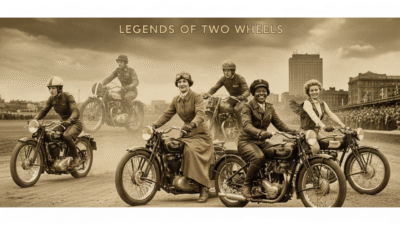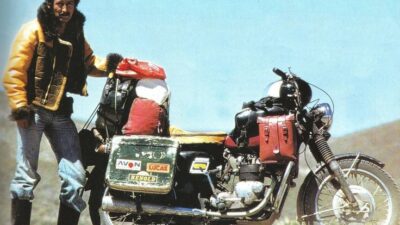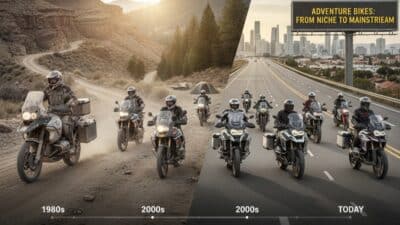The roar of an engine, the rush of wind, the endless ribbon of road stretching before you – for many, this is the ultimate symbol of freedom. But for women, straddling a motorcycle has represented far more than just a thrilling ride; it has been a powerful, undeniable force in Motorcycles and their role in women’s liberation. From defying societal norms to forging new paths of independence, the motorcycle has served as a two-wheeled chariot of change, enabling women to break free from conventional expectations and embrace a life on their own terms. This isn’t just about speed; it’s about courage, community, and the unyielding spirit of adventure.
Historically, the image of a woman on a motorcycle was scandalous, a direct challenge to the demure, confined roles society often dictated. Yet, with every twist of the throttle, women riders have dismantled these stereotypes, asserting their strength, autonomy, and capability. The motorcycle, inherently a machine of power and self-reliance, became an extension of their burgeoning desire for equality and self-expression. It’s a story of grit, passion, and the exhilarating journey towards empowerment.
The Early Roar: Paving the Way for Freedom
Imagine a world where women were expected to be chaperoned, veiled, and restricted to the domestic sphere. Then, envision a woman, perhaps dressed in practical trousers, confidently kicking to life a powerful machine, ready to conquer the open road. This wasn’t just a scene from a rebellious film; it was a reality for pioneers who dared to dream differently. The early 20th century saw the nascent stages of women embracing motorcycling, a truly revolutionary act.
These trailblazers weren’t just riding for pleasure; they were riding for purpose. They were delivering messages during wartime, exploring vast landscapes, and proving their physical and mental prowess in a male-dominated arena. Each mile covered was a statement, a testament to their strength and determination. Figures like Augusta and Adeline Van Buren, who rode across the United States in 1916 on Indian Powerplus motorcycles, weren’t merely adventurers; they were suffragists using their epic journey to advocate for women’s rights and prove their ability to serve as military dispatch riders. Their journey, often through unpaved roads and challenging conditions, captured national attention and ignited a spark of possibility for countless other women.
The motorcycle itself, a symbol of industrial innovation and personal mobility, became a tangible tool for liberation. It offered speed, distance, and a sense of mastery that was profoundly empowering. For the first time, many women experienced an unadulterated sense of self-reliance and the thrill of navigating the world on their own terms. It challenged the notion that women were delicate and fragile, incapable of handling powerful machinery or facing the rigors of the road. This early adoption laid the groundwork for future generations, normalizing the image of a woman in the saddle and chipping away at patriarchal structures.
| Pros | Cons |
|---|---|
| – Unparalleled sense of freedom and independence | – Higher risk of injury compared to cars |
| – Empowers women by challenging gender stereotypes | – Societal prejudices and stereotypes still exist |
| – Fosters a strong sense of community and sisterhood | – Physical demands can be challenging for some |
| – Develops mechanical skills and self-reliance | – Initial cost and maintenance can be significant |
| – Provides a unique platform for self-expression | – Weather dependency can limit riding opportunities |

The Roaring Twenties and Beyond: A Symbol of Rebellion
As society loosened its corsets in the 1920s, so too did women shed traditional constraints. The flapper era, synonymous with breaking norms, found a natural ally in the motorcycle. Short skirts, bobbed hair, and a motorcycle between the legs became an icon of the modern woman – adventurous, independent, and unafraid to challenge the status quo. These women weren’t just passengers; they were operators, taking the reins of their own destiny, both literally and metaphorically.
The motorcycle represented an escape from the confines of the home and the expectations of domesticity. It offered a pathway to explore, to socialize freely, and to experience the world in a visceral, unfiltered way. Women riders embraced the thrill, the danger, and the sheer audacity of it all. This rebellious spirit continued through the decades, gaining momentum after World War II when many women had experienced newfound independence in the workforce and were reluctant to return to pre-war limitations. They had driven ambulances, operated heavy machinery, and now, they wanted to ride motorcycles.
The post-war era saw the rise of motorcycle clubs, and while initially male-dominated, women gradually carved out their own spaces. The “biker chick” stereotype, often sensationalized in media, paradoxically highlighted a woman who was tough, independent, and sexually liberated – characteristics that, despite their problematic portrayals, still signaled a departure from traditional femininity. It was a potent image, one that, for better or worse, placed women squarely in the driver’s seat of their own narratives.
Embracing Mechanical Mastery: Beyond the Ride
Beyond the sheer exhilaration of speed and freedom, motorcycling often introduces riders to the mechanics of their machines. For women, this aspect has been particularly empowering. Understanding how an engine works, how to perform basic maintenance, and even how to troubleshoot common issues demystifies technology and cultivates a profound sense of self-reliance. It challenges the antiquated notion that mechanical aptitude is exclusive to men.
Learning to inspect and clean carburetors on your motorcycle, for example, is not just a practical skill; it’s a step towards complete independence. It means less reliance on others and a deeper connection to your machine. This hands-on engagement fosters confidence, problem-solving skills, and a practical understanding of engineering principles. When a woman can confidently explain the difference between a two-stroke and a four-stroke engine, or meticulously adjust her chain, she’s not just a rider; she’s a master of her craft.
This mechanical knowledge extends to safety and preparedness. Knowing how to remove and replace motorcycle wheels or performing a quick check before a long journey contributes significantly to a rider’s overall confidence and ability to handle unexpected situations on the road. The motorcycle, therefore, becomes not just a mode of transport but a classroom, teaching invaluable life skills that transcend the garage.

Building Communities: Sisterhood on Two Wheels
While riding a motorcycle often evokes images of solitary freedom, it also fosters incredibly strong communities. For women, these communities have been vital to their liberation journey. Women’s motorcycle clubs, online forums, and local riding groups provide a safe, supportive space where female riders can share experiences, offer advice, and build lasting friendships. These groups actively counter stereotypes, proving that women riders are diverse, capable, and united by a shared passion.
These communities are instrumental in normalizing women in motorcycling. They organize charity rides, skill-building workshops, and social gatherings, creating a visible presence that inspires new riders. When a novice woman rider sees a group of experienced female bikers, the path forward becomes clearer and less intimidating. The camaraderie found within these groups often transcends socio-economic backgrounds, professions, and ages, uniting women who might otherwise never cross paths. It’s a powerful network that celebrates individual triumphs and offers collective support, reinforcing the idea that women can thrive and lead in any domain.
The shared understanding of the challenges and joys of motorcycling creates an unbreakable bond. From tips on handling various road conditions to recommendations on gear, these networks are invaluable. For instance, discussions around tips for riding a motorcycle in the rain and wet weather are common, providing practical advice that enhances safety and enjoyment for all members. This collective wisdom and mutual encouragement are hallmarks of the sisterhood built around the open road.
The Modern Woman Rider: Diverse, Powerful, and Present
Fast forward to today, and the landscape of women in motorcycling is more vibrant and diverse than ever before. While statistics vary, there’s a clear upward trend in female ridership globally. Women are not just riding cruisers or scooters; they are on sportbikes, adventure touring motorcycles, dirt bikes, and even competing in races. The motorcycle industry has taken notice, with more inclusive gear, ergonomic designs, and marketing campaigns that celebrate female riders.
The modern woman rider embodies a spectrum of identities. She could be a professional commuting to work, a mother taking weekend trips, an adventurer exploring remote landscapes, or a racer pushing the limits on the track. This diversity shatters any remaining monolithic stereotypes about who a “biker chick” is. She is simply a rider, passionate about her machine and the freedom it affords.
The empowerment extends beyond the saddle. Women are also becoming motorcycle mechanics, designers, journalists, and business owners within the industry, further cementing their role and influence. They are shaping the future of motorcycling, advocating for greater safety, inclusivity, and environmental consciousness, especially with the rise of electric motorcycles, which presents new opportunities for innovation and accessibility. From the very first steam-powered two-wheeler, the journey of motorcycles has always been intertwined with progress, and for women, it continues to be a vehicle for advancement.

Overcoming Obstacles: Pushing Boundaries
Despite the significant strides made, women in motorcycling still face unique challenges. Societal perceptions, though evolving, can still be a hurdle. Some women encounter skepticism about their riding abilities, or face assumptions about why they ride. There are also practical considerations, such as finding gear that fits well and offers adequate protection for female body types, or dealing with the physical demands of larger, heavier bikes.
However, these challenges often become opportunities for further empowerment. The resilience required to navigate these obstacles strengthens the resolve of women riders. By choosing to ride, by mastering their machines, and by advocating for themselves, they continue to push boundaries and inspire others. The act of confronting and overcoming these hurdles is, in itself, a liberating experience, reinforcing their confidence and determination.
Safety is, of course, a paramount concern for all riders, and women are particularly diligent in this area. They often seek out advanced training, practice defensive riding techniques, and ensure their bikes are meticulously maintained. This commitment to safety is a testament to their responsible approach to the sport and another example of how they take charge of their own journeys.

The Motorcycle as a Metaphor for Life
Ultimately, the motorcycle’s role in women’s liberation transcends its function as a mode of transport. It serves as a powerful metaphor for life itself. The open road represents infinite possibilities, the engine symbolizes inner strength, and the helmet signifies protection and focus. Riding a motorcycle teaches invaluable lessons about balance, control, risk assessment, and perseverance. It demands presence, acute awareness, and a willingness to confront fears.
For women, these lessons resonate deeply with the broader journey of liberation. It’s about taking control, making choices, and charting one’s own course, even when the path is uncertain or challenging. The exhilaration of leaning into a curve, the satisfaction of a perfectly executed gear shift, and the sheer joy of feeling the wind on your face are all visceral reminders of personal agency and the power of individual will.
The bond between a woman and her motorcycle is often described as profound and personal. It’s a relationship built on trust, respect, and shared adventures. This connection allows for a unique form of self-discovery, fostering introspection and a deeper understanding of one’s own capabilities and desires. In a world that often seeks to define women, the motorcycle offers a blank canvas for self-definition.

The journey of Motorcycles and their role in women’s liberation is far from over. As more women discover the profound joys and empowerment that riding offers, the culture continues to evolve. The future promises even greater inclusivity, innovation, and recognition for female riders across the globe. From historical pioneers defying conventions to modern-day adventurers blazing new trails, women on motorcycles are not just making noise; they are making history, one throttle twist at a time. So, if the call of the open road whispers to your soul, answer it. Embrace the challenge, join the sisterhood, and discover the exhilarating freedom that awaits.
Frequently Asked Questions
What made motorcycles such a significant tool for women’s liberation?
Motorcycles offered unparalleled freedom, independence, and a direct challenge to restrictive gender norms. They allowed women to travel unchaperoned, demonstrate mechanical competence, and embody a rebellious spirit, breaking free from traditional societal expectations.
Who were some of the early pioneers of women in motorcycling?
Augusta and Adeline Van Buren are prominent examples, who undertook a cross-country ride in 1916 to advocate for women’s rights and their ability to serve as military dispatch riders. Many other unnamed women also pushed boundaries in the early 20th century.
How did motorcycles help women challenge gender stereotypes?
By riding powerful machines and navigating challenging roads, women riders debunked the idea of female fragility and proved their strength, skill, and courage in a traditionally male-dominated activity. This visibly challenged societal perceptions of women’s capabilities.
What kind of communities have developed around women and motorcycling?
Strong communities have formed through women’s motorcycle clubs, online forums, and local riding groups. These provide supportive networks for sharing experiences, fostering friendships, and empowering women in the sport.
Is mechanical knowledge important for women riders?
Yes, embracing mechanical skills like understanding engine basics or learning how to inspect and clean carburetors on your motorcycle fosters self-reliance, confidence, and a deeper connection to the machine, further contributing to their overall empowerment.
What are some current trends in women’s motorcycling?
Today, female ridership is increasing across all motorcycle types, from sportbikes to adventure bikes. The industry is also responding with more inclusive gear and marketing. Women are also taking on roles as mechanics, designers, and industry professionals.
What does the motorcycle symbolize for women today?
For many women, the motorcycle symbolizes not just freedom and independence, but also personal power, resilience, self-discovery, and the ability to chart one’s own course in life, acting as a metaphor for their journey of liberation.



